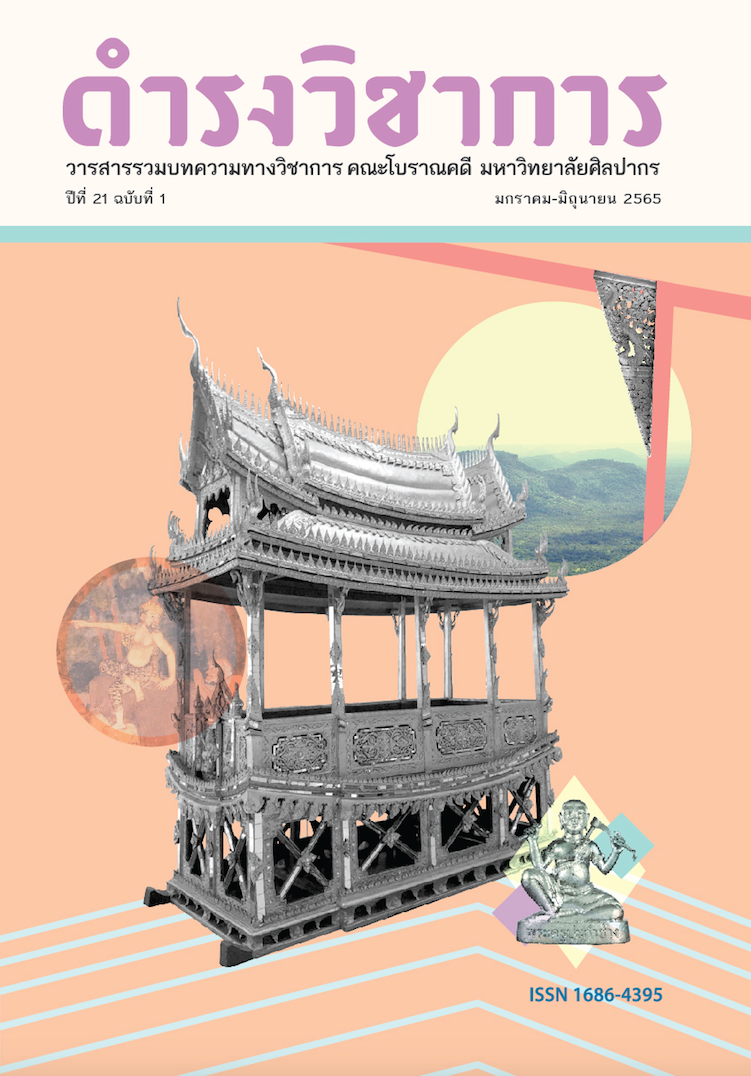Viharn Nam Taem - Viharn Phra Chao Sila of Wat Phra That Lampang Luang: The Changes of Naga Than and the Assumptions about the Ages of the Halls
Keywords:
Wiharn, Naga Than, Wiharn Nam Taem, Wiharn Phra Chao Sila, Wat Phra That Lampang LuangAbstract
Viharn Nam Taem and Viharn Phra Chao Sila were built in the traditional Lanna style, situated on a low foundation. The viharn's foundation and walls were constructed to have two rooms stand out in front and one in the back. The viharn’s roofs were lowered in line with the gauges. There is also a wooden lid (Fa Yoi) with painted patterns corresponding to the phrases painted on the pillars and on the walls of Viharn Nam Taem, unlike the Viham of Phra Chao Sila, which employs concrete to make smooth plaster.
Furthermore, roof decorations such as the ornamental roof point or Gabel apex, toothlike ridges on the sloping edges of a gable, and other attractive decorations, were handcrafted in the central area. The gable and decorative extension of the gable (Kong Kiw) were made entirely of concrete. Previous research indicates that these two viharas existed prior to the 24th Buddhist Era. Vihara Phra Chao Sila might have been constructed with artifacts or when the Praput viharn and the viharn Nam Taem were constructed. Viharn Nam Taem is an ancient viharn where all examples of earlier pieces of art have been restored to their original design.
According to scholars, the Naga Than is a highly important structure that has had relatively little restoration. There are two theories on the Naga Than of Viharn Nam Taem. First, it is thought to be from the 21st Buddhist century or, second, to be no older than the 23rd Buddhist century. The Naga Than of Viham Phra Chao Sila was established at the same time as the Nam Taem Vihara. The author discovered that the Naga that appears now was not the original one but was renovated later. The Naga Than Vihara of Nam Taem were created in two periods, and are no older than the 23rd Buddhist century and the 24th Buddhist century. The Naga Than of Viharn Phra Chao Sila is clearly a work of a later generation than the one behind the Viharn Nam Taem, that is, around the end of the 23rd to the 24th Buddhist century. There were still frequent renovations until the 25th Buddhist century.
References
Scott W. Morton, (c2005). China : Its History and Culture. New York : McGraw-Hill.
เปลื้อง ณ นคร, (2516) พจนะ-สารานุกรม ฉบับทันสมัย. กรุงเทพฯ : ไทยวัฒนาพานิช.
กรมศิลปากร, (2542). ประชุมพงศาวดารฉบับกาญจนาภิเษก เล่ม 2. กรุงเทพฯ : กองวรรณกรรมและประวัติศาสตร์ กรมศิลปากร.
ณัฏฐภัทร จันทวิช, (2537). เครื่องถ้วยจีนจากแหล่งโบราณคดีในประเทศไทย. กรุงเทพฯ: กรมศิลปากร.
พรรณิภา ปิณฑวณิช, (2549). การศึกษารูปแบบทางสถาปัตยกรรมวัดพระธาตุลำปางหลวง จังหวัดลำปาง วิทยานิพนธ์ปริญญาศิลปศาสตรมหาบัณฑิต, สาขาประวัติศาสตร์สถาปัตยกรรม, บัณฑิตวิทยาลัย, มหาวิทยาลัยศิลปากร.
พระยาประชากิจจักร, (2507). พงศาวดารโยนก. พระนคร : คลังวิทยา.
วรลัญจก์ บุญยสุรัตน์, (2544). วิหารล้านนา. กรุงเทพฯ : ด่านสุทธาการพิมพ์.
วิบูลย์ ลี้สุวรรณ, (2535). พจนานุกรมศัพท์ศิลปกรรมไทย. นนทบุรี : เมืองโบราณ.
ศักดิ์ชัย สายสิงห์, (2551). งานช่าง สมัยพระนั่งเกล้าฯ. กรุงเทพฯ : มติชน.
____________, (2555). วัดพระธาตุลำปางหลวง. กรุงเทพฯ : กรมศิลปากร.
สมคิด จิระทัศนกุล, (2559). อภิธานศัพท์ช่างสถาปัตยกรรมไทย. กรุงเทพฯ : คณะสถาปัตยกรรมศาสตร์ มหาวิทยาลัยศิลปากร.
สันติ เล็กสุขุม, (2553). พัฒนาการของลายไทย : กระหนกกับเอกลักษณ์ไทย. กรุงเทพฯ : เมืองโบราณ.
สุรพล ดำริห์กุล, (2559) ลายคำล้านนา. กรุงเทพฯ : เมืองโบราณ.
Downloads
Published
Issue
Section
License
Copyright (c) 2022 Damrong Journal of The Faculty of Archaeology Silpakorn University

This work is licensed under a Creative Commons Attribution-NonCommercial-NoDerivatives 4.0 International License.
บทความนี้เป็นผลงานของข้าพเจ้าแต่เพียงผู้เดียว และ/หรือเป็นผลงานของข้าพเจ้าและผู้ร่วมงาน ตามชื่อที่ระบุในบทความจริง และเป็นผลงานที่มิได้ถูกนำเสนอหรือตีพิมพ์ที่ใดมาก่อน





